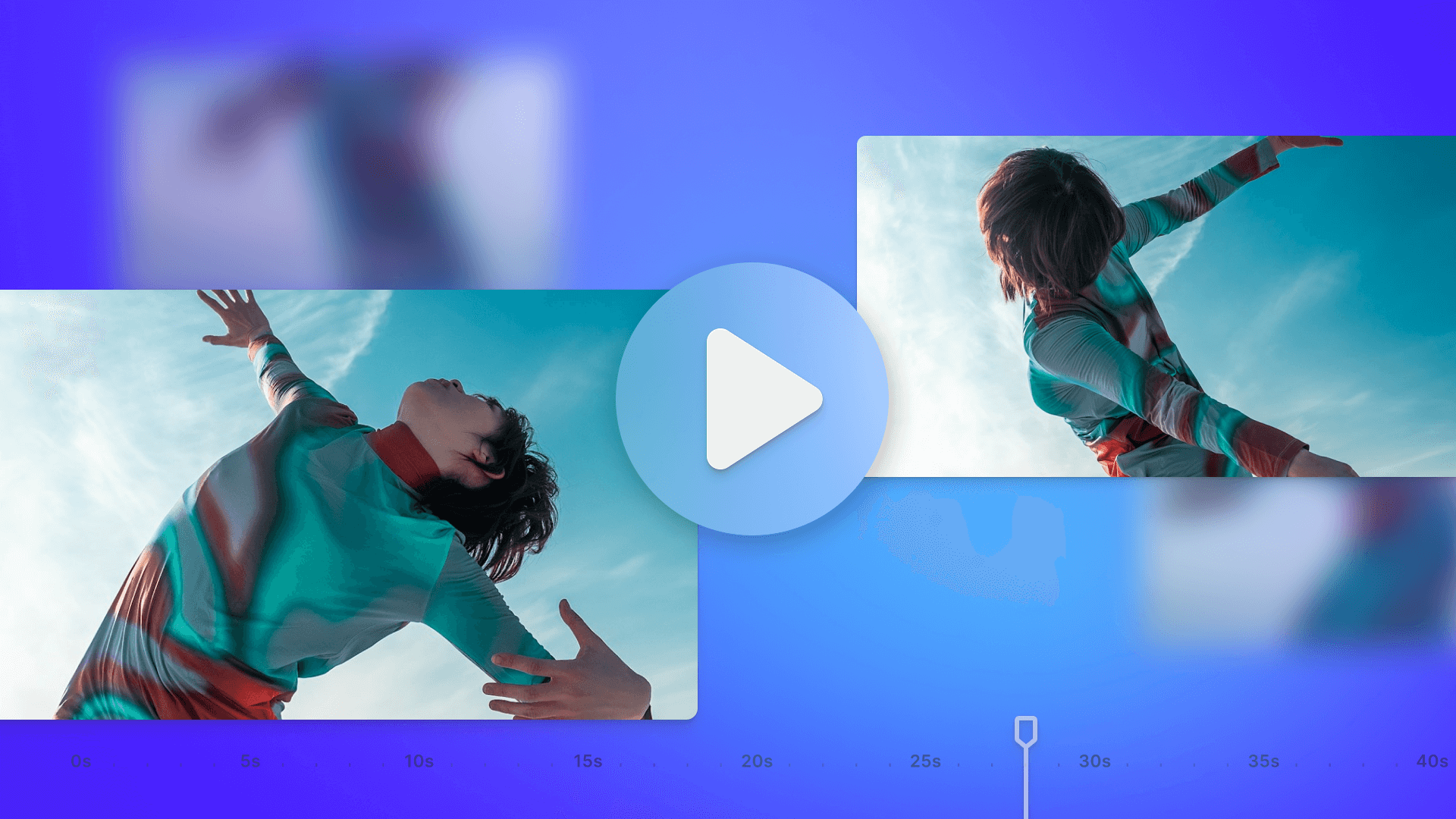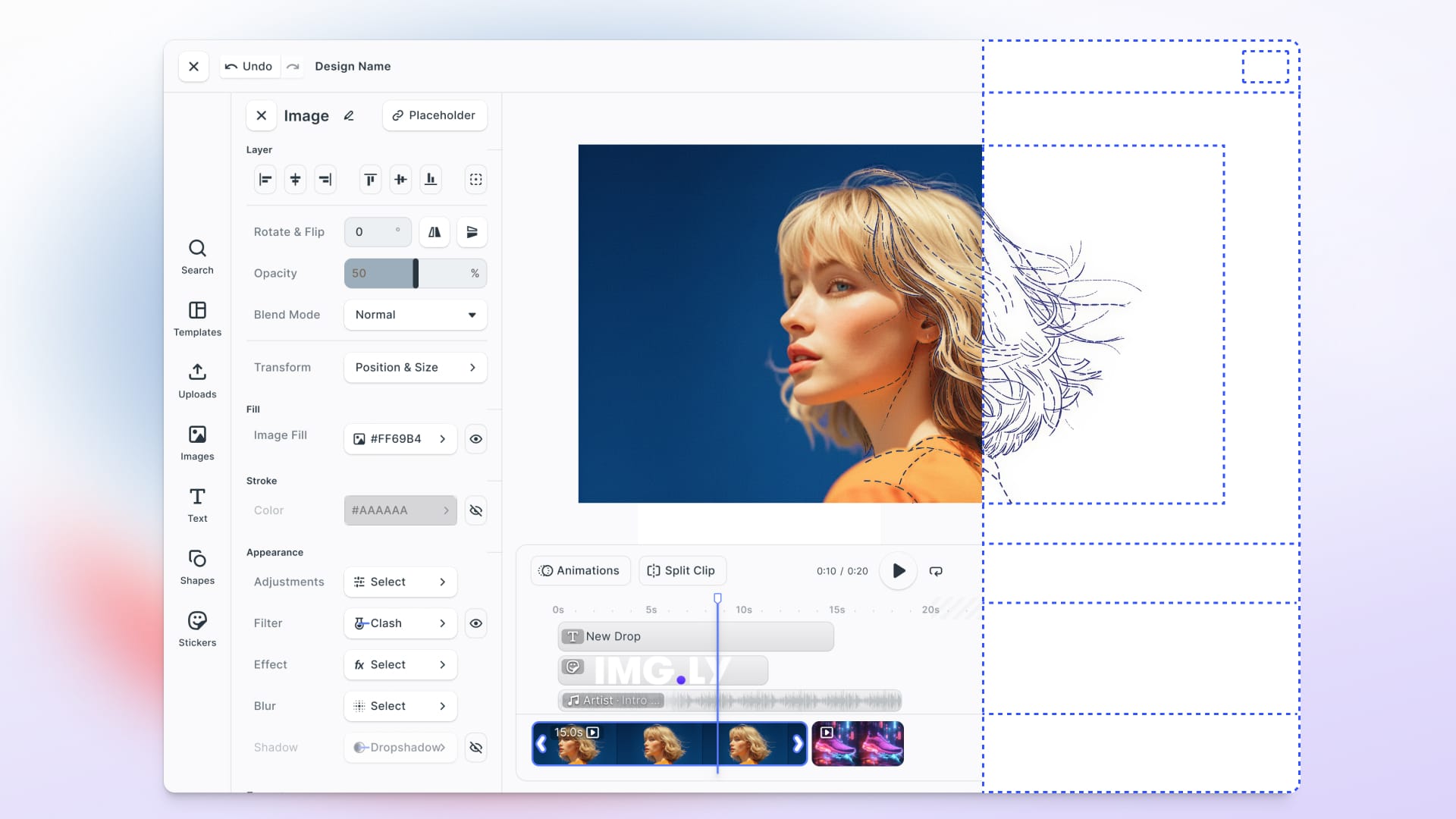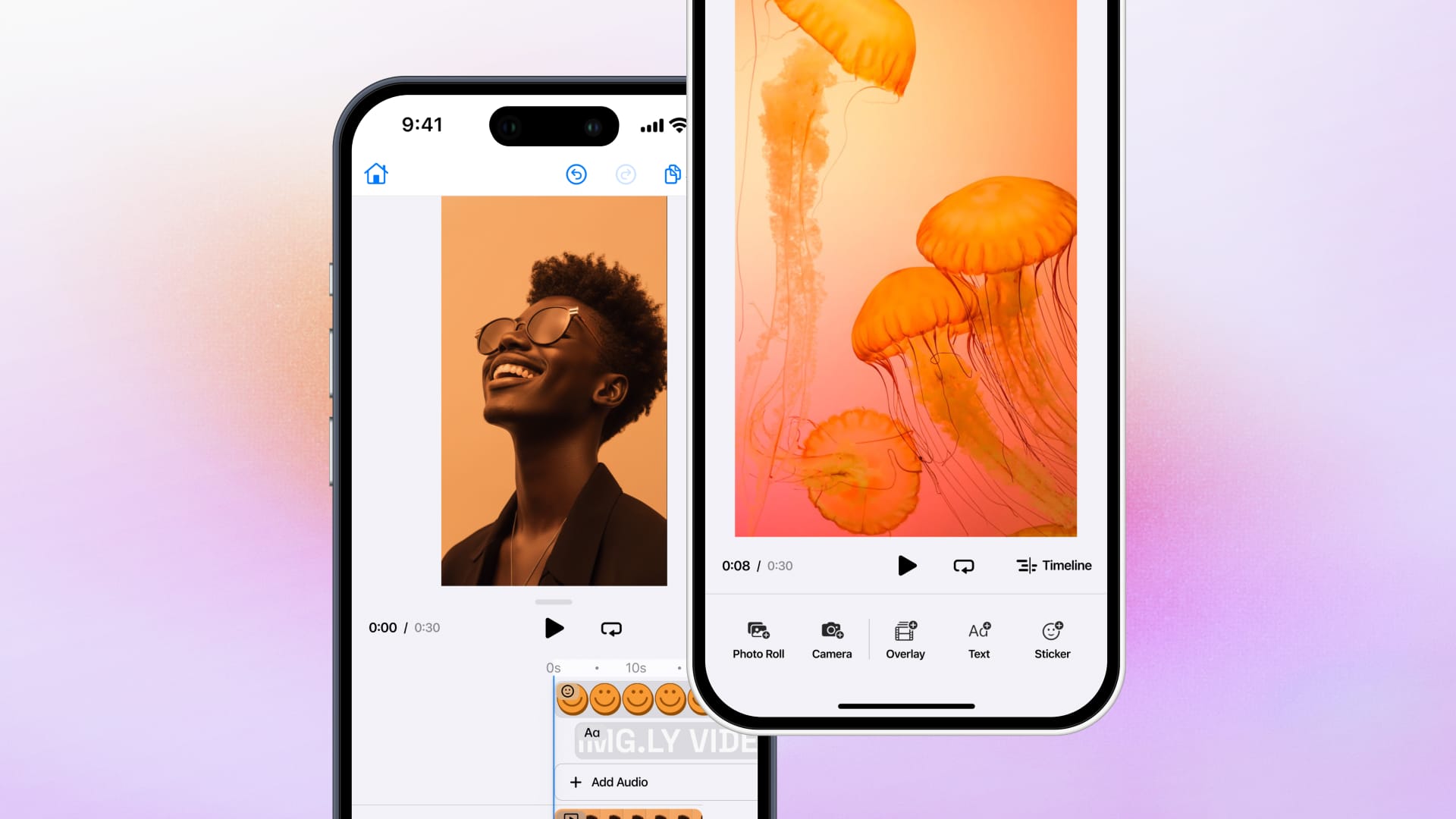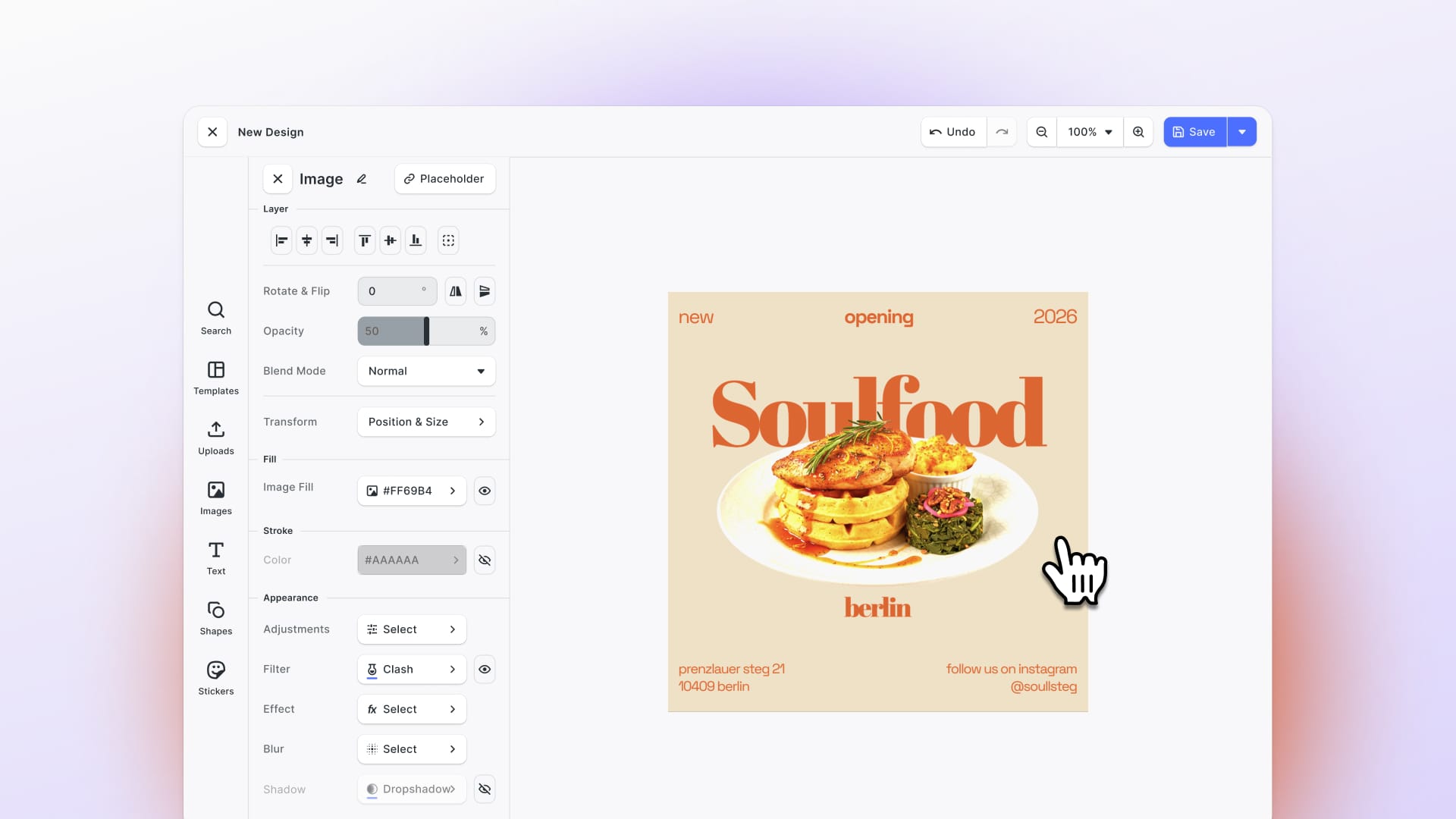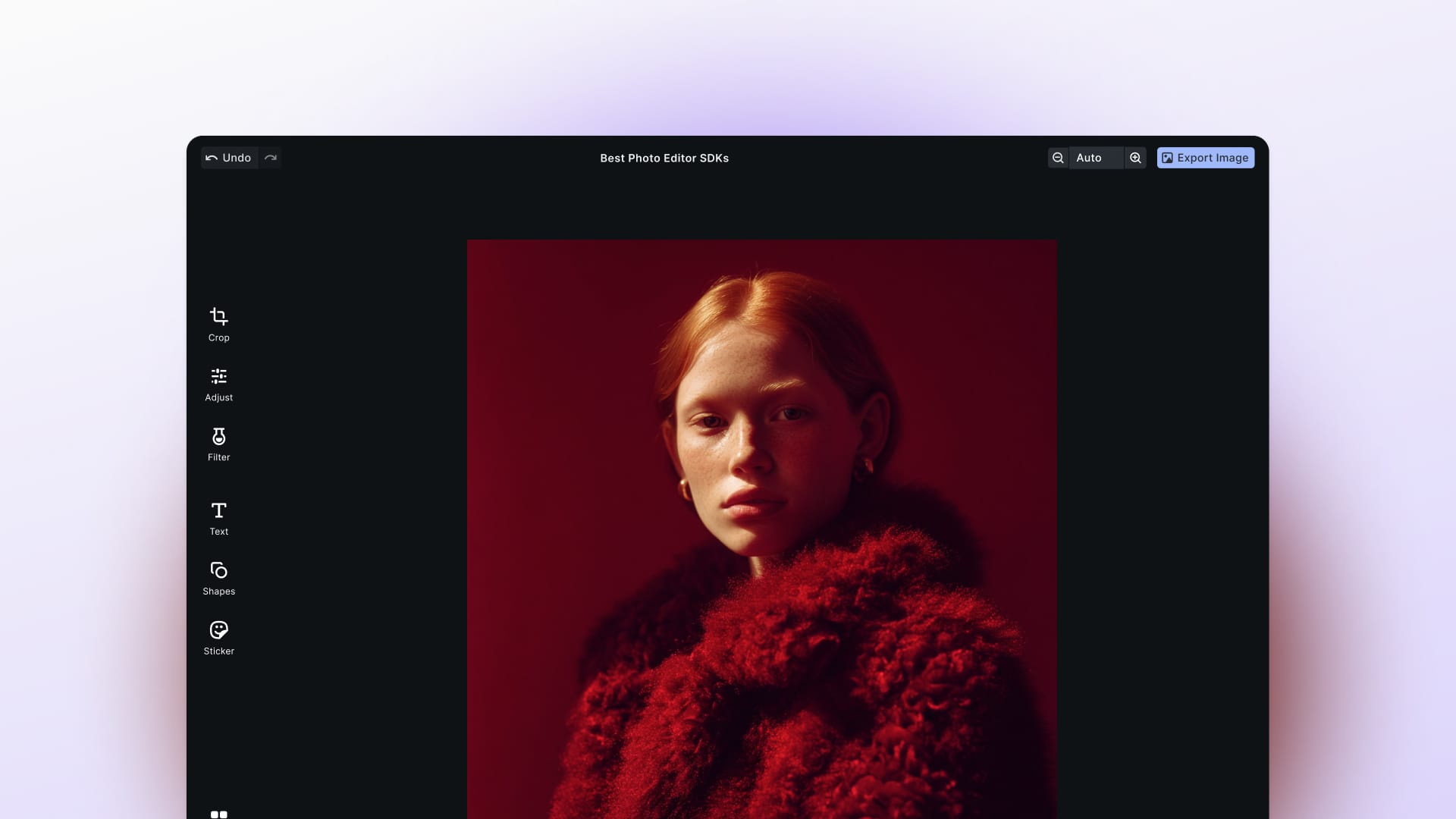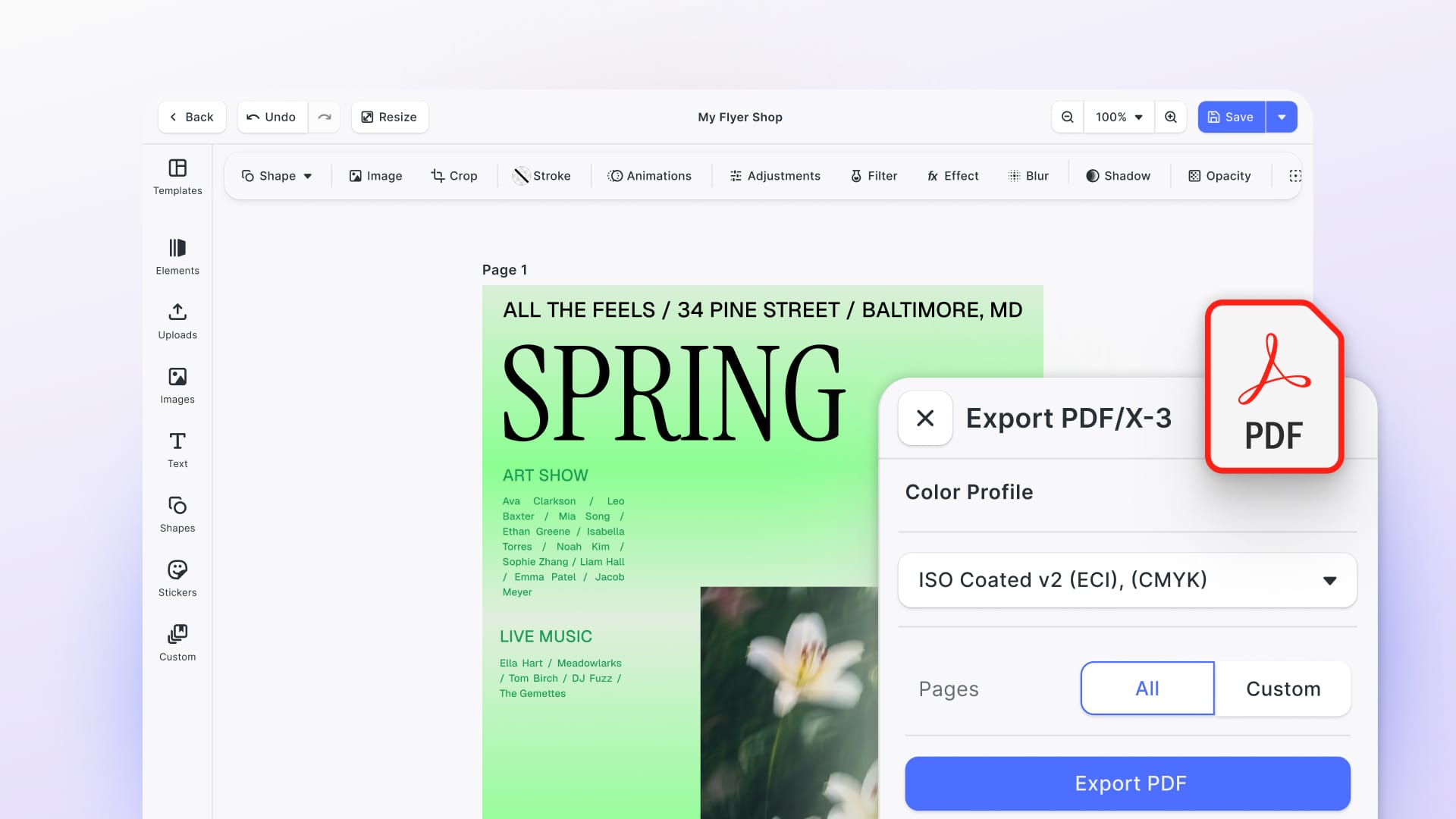With dozens of video editing SDKs on the market, choosing the right one can feel like a daunting task.
To help you cut through the noise, we’ve put together a breakdown of the 7 best video editing SDKs in 2025: IMG.LY, Meishe SDK, Banuba, Shotstack, BytePlus Effects, Rendley, and Picsart. We’ll cover:
- Key features and capabilities
- Supported platforms and customization options
- Ideal use cases and trade-offs
This guide is unbiased, but we’ll also highlight how IMG.LY compares and where it stands out as the only solution that combines a polished editor with scalable automation in a single package.
1. IMG.LY CreativeEditor SDK (CE.SDK)
Choosing IMG.LY means selecting a platform that offers both: a Canva-grade editor for your users and a powerful Engine API for automation. That dual focus is what sets CE.SDK apart.
- Features & capabilities: CE.SDK works best when you see it as a bridge between what end users expect and what your product team needs behind the scenes. On the surface, users get familiar tools including multi‑track editing, ready‑made templates, and a growing set of AI features like text‑to‑image, text‑to‑video, and AI voiceovers. Behind the scenes, developers can extend and customise with a plugin system so the editor adapts as your product evolves.
- Platforms & customization: This flexibility carries over to platforms. CE.SDK works across Web, iOS, Android, React Native, Flutter, Electron, and Node.js. It’s also fully white‑label, which means your customers see a seamless extension of your brand, not a third‑party tool.
- Implementation & use cases: Getting started with our tool doesn’t require a huge lift. Teams can spin up a proof of concept quickly, then scale into enterprise deployment when ready. That’s why you’ll see CE.SDK inside SaaS platforms, e‑commerce personalization tools, DAM systems, and even social networks.
- Future‑proofing, support & pricing: What reassures teams is the long‑term roadmap: regular feature releases, AI integrations, and direct support from solution engineers. Enterprise SLAs and SSO come standard. Pricing depends on the usage, which makes it easier to scale without committing to rigid licensing.
- Who it's for: CE.SDK is valuable for SaaS, MarTech, e-commerce, and DAM platforms. These teams need to give users a simple, branded editing experience while also managing complex automation in the background. Instead of stitching together multiple tools or sacrificing one capability for another, CE.SDK provides an all-in-one foundation: polished editing, scalable automation, enterprise-grade support, and ongoing AI-driven innovation.
Key differentiator
CE.SDK doesn’t force you to choose between usability and power. On one side, it delivers a polished, user-facing editor that feels familiar to end users. On the other hand, it provides a powerful automation engine that scales with your product. Most SDKs lean heavily in one direction. They either focus on end-user editing or specialize in backend automation. CE.SDK is different because it combines both in a single platform.
2. Meishe SDK (Meicam)
Meishe SDK, also known as Meicam, is a mature Chinese SDK that has carved out a space in many professional apps across Asia. Think of it as a toolkit built for industries that need stability and advanced editing power, though it comes with a few trade‑offs that teams should weigh carefully.
- Features & capabilities: Meishe offers multi‑track timelines, real‑time effects, and plugin support across mobile, web, and PC. Industries like automotive, broadcasting, and education have already used Meishe successfully, showing how it handles complex and demanding video workflows.
- Platforms & customization: It supports full UI customization, white‑labeling, and plugins. And while customization depth is solid, integration tends to be heavier compared to other tools. Documentation can feel dense, which sometimes slows teams down as they work toward launch.
- Implementation & use cases: Meishe SDK is beginning to layer in AI integrations like intelligent editing and motion tracking. For large organizations in Asia with strong internal dev resources, these capabilities can be appealing.
- Future‑proofing, support & pricing: Meishe continues to expand with new AI features like facial recognition and virtual anchors. It also offers custom enterprise support agreements. However, teams often struggle with the integration process, and the developer experience feels less polished. Setting up complex projects can take longer, and the documentation isn’t as approachable, which leaves some developers hesitant to adopt it widely. Pricing typically follows an enterprise licensing model, which can be less flexible for fast‑scaling SaaS companies.
- Who it's for: Meishe SDK is best suited for large-scale apps in Asia and companies with internal dev resources.
How it compares to IMG.LY
Meishe delivers solid editing capabilities and is a proven choice in professional and regional contexts. But the trade‑offs become clear when you look at integration and support. It can feel heavy to implement, and documentation isn’t as approachable.
IMG.LY pulls ahead here with stronger web support, compatibility with creative file types like PSD, AI, and INDD, and a faster onboarding process that makes it easier for teams to move from idea to production.
Learn more about how IMG.LY compares to Meishe SDK here.
3. Banuba
Banuba is a mobile‑first SDK with a strong focus on augmented reality (AR). It has built its reputation on powering social and UGC apps with effects that mimic the TikTok experience. If your product relies on immersive filters, beauty effects, or virtual try‑on, Banuba often appears at the top of the evaluation list.
- Features & capabilities: The SDK provides a TikTok‑like editor with AR masks, beauty filters, face tracking, background removal, and even virtual try‑on features. These tools are designed to keep users engaged with interactive and shareable content.
- Platforms & customization: Banuba supports iOS, Android, Flutter, and React Native. It offers modular components with a preset UI, which makes implementation faster for mobile. That said, customization options are limited when compared to solutions designed for enterprise-level flexibility.
- Implementation & use cases: Integration is relatively quick for mobile teams, and the SDK has proven popular among social media platforms, beauty apps, and e‑commerce companies offering AR try‑on. However, support for web or large‑scale enterprise environments is limited, which narrows its scope.
- Future‑proofing, support & pricing: The company continues to expand its AR and AI features, focusing on personalization and beauty‑driven effects. Banuba operates with a smaller team of about 70 employees, which can affect the pace of enterprise‑grade support. Licensing costs are typically high and not publicly disclosed, which may be a barrier for smaller companies.
- Who it's for: Banuba is best suited for mobile apps that need advanced AR features like beauty filters, face tracking, or virtual try‑on to keep users engaged.
How it compares to IMG.LY
Banuba leads when it comes to AR‑driven capabilities, making it a natural fit for beauty and social platforms. But when teams look beyond filters to enterprise readiness, automation, and cross‑platform support, other options such as IMG.LY offer broader possibilities.
Learn more about how IMG.LY compares to Banuba here.
4. Shotstack
Shotstack focuses squarely on automation. It's a cloud‑based video editing API designed for bulk rendering rather than end‑user editing. Teams often evaluate it when they need to generate thousands of videos quickly and at scale.
- Features & capabilities: Shotstack runs on a JSON‑driven API that lets developers programmatically create and assemble video content. With this approach, teams can handle automated ad generation, personalization, or large‑scale marketing campaigns. While powerful for automation, it doesn’t include a native editor, which means you must build a custom UI if you want end‑user editing.
- Platforms & customization: Shotstack is built as a REST API in the cloud, so it fits naturally into modern development stacks. It allows teams to design workflows programmatically, though the absence of prebuilt UI components makes it harder to use the tool right away as compared to other SDKs.
- Implementation & use cases: Developers appreciate the smooth onboarding experience and clear API structure. Typical use cases include bulk rendering of ads, dynamic personalization for campaigns, and other scenarios where scaling output matters more than in‑app editing.
- Future‑proofing, support & pricing: Shotstack continues to invest in automation and AI‑powered generation, offering tools that personalize video creation at scale. The vendor provides commercial SLAs, but support resources remain limited given the team size. Pricing follows a pay‑as‑you‑go model ($0.30 per minute) or subscription plans, which can work well for predictable, high‑volume usage.
- Who it's for: Shotstack is best suited for teams that need scalable rendering pipelines and automation rather than in‑app editing features.
How it compares to IMG.LY
Shotstack gives you powerful rendering automation and programmatic workflows. IMG.LY takes it further by combining those automation strengths with a complete, user‑facing editor, so you can address both your development needs and your end‑users’ experiences in one solution.
Get a detailed comparison of IMG.LY CreativeEditor SDK and Shotstack here.
5. BytePlus Effects
BytePlus Effects is modelled after TikTok and CapCut. It’s designed to give app developers the same kind of short‑form, social‑first experience that has made those platforms successful. As a result, it appeals to teams that want to replicate TikTok‑like engagement inside their own apps.
- Features & capabilities: The SDK offers more than 80,000 effects and filters, including AR stickers and beautification tools. These features aim to keep users engaged by giving them endless ways to personalize and enhance their content.
- Platforms & customization: BytePlus integrates with iOS, Android, React Native, and Flutter, making it a strong option for mobile‑first development. You can customise the UI to match your brand, but customization beyond theming is limited, which can be a constraint if you need deeper control.
- Implementation & use cases: Since it’s optimized for mobile integration, you can embed it relatively quickly into short‑form consumer video apps. Common use cases include social platforms, beauty apps, and any consumer‑facing product that thrives on AR‑enhanced video.
- Future‑proofing, support & pricing: With the backing of TikTok’s ecosystem, BytePlus is evolving rapidly, adding new AI‑driven AR and beauty effects frequently. However, commercial support feels less transparent, and licensing comes through enterprise negotiations with annual fees. This structure can work for large consumer platforms, but may be harder for smaller teams.
- Who it's for: BytePlus is best suited for apps that want to recreate TikTok‑style user experiences and rely heavily on prebuilt AR effects to keep users engaged.
How it compares to IMG.LY
BytePlus takes a step ahead when it comes to prebuilt effects and AR‑driven experiences. But if you need more flexibility in customization, automation capabilities, or enterprise‑grade workflows, IMG.LY offers a broader solution.
For a detailed comparison, take a look at our guide on IMG.LY vs BytePlus Video Editor.
6. Rendley
Rendley is a newer player in the SDK space and has gained attention because of its browser‑only approach. It’s JavaScript‑based and runs entirely in the browser, which means you don’t need a server to get started. This makes it attractive for teams that want a lightweight, client‑only setup without managing infrastructure.
- Features & capabilities: The SDK supports multi‑track editing, keyframes, and even integrates with After Effects (AE). These features give frontend developers enough flexibility to build interactive editing experiences directly in the browser.
- Platforms & customization: Rendley runs entirely in the browser, which makes it a natural fit for lightweight web apps and UGC platforms. Developers get flexibility through an open, in‑browser approach. However, without enterprise‑level frameworks, scaling to larger organizations becomes more difficult.
- Implementation & use cases: Setting up Rendley is straightforward for frontend teams, which makes it appealing for lightweight UGC applications or smaller web projects. That ease of entry, however, comes with limits: AI integrations aren’t a core focus, so its potential for more advanced future applications remains restricted.
- Future‑proofing, support & pricing: Rendley is still early‑stage and hasn’t yet proven itself at enterprise scale. Support is provided by a small vendor team, which can make long‑term stability less certain. Pricing details are not publicly available, leaving prospective users to negotiate directly.
- Who it's for: Rendley fits developers who want a browser‑native, client‑only editing tool without the need for server infrastructure.
How it compares to IMG.LY
Rendley works well as a lightweight, browser‑native solution. But if you need enterprise‑grade robustness, automation, or dedicated support, IMG.LY offers more comprehensive coverage.
Learn more about how IMG.LY is a great alternative for Rendley.
7. Picsart Video SDK
Picsart Video SDK is an embeddable video editor SDK that brings Picsart’s creative editing tools into third-party apps or websites.
- Features & capabilities: This SDK brings the company’s well‑known creative editing tools into third‑party products. Out of the box, you get features like trimming, multi‑scene editing, transitions, dynamic audio, subtitles, and text overlays, enough to cover the basics of video creation. AI‑driven tools extend these capabilities with smarter image and video editing options.
- Platforms & customization: The SDK is React Native‑based but optimized for web embedding, making it appealing for web‑first platforms. You can configure the UI, apply theming, white‑label the experience, toggle features on or off, and integrate your own asset library so the editor matches your product’s design and workflow.
- Implementation & use cases: One of Picsart’s strengths is ease of setup: installation is fast, with a React editor installation process that reduces complexity, documentation is detailed, and the editor is designed to embed with minimal lift. This makes it a good choice for advertising or marketing platforms, edu‑tech products, and media platforms that want to give users creative tools quickly.
- Future‑proofing, support & pricing: The SDK is backed by Picsart’s large ecosystem and its AI research arm (PAIR), so teams can expect regular updates, new features, and scalable performance. Support comes through developer documentation, a support team, and enterprise collaboration options. Pricing isn’t public, but it’s likely offered as enterprise or usage‑based licensing.
- Who it's for: Picsart’s Video SDK is best for teams that need a web‑based video editor to power product features or educational video production without investing heavily in custom development.
How it compares to IMG.LY
Picsart offers a fast, embeddable editor with AI effects and a strong ecosystem. However, IMG.LY provides deeper customization, more automation capabilities, cross‑platform support, and enterprise‑grade integrations.
Overview Table (Use Cases vs. Solutions)
| Use Case / Solution | IMG.LY | Meishe | Banuba | Shotstack | BytePlus | Rendley | Picsart |
|---|---|---|---|---|---|---|---|
| Marketing tech | ✅ Enables polished campaigns with templates, AI tools, and automation built into the editor. | ⚠️ Supports marketing but often requires significant developer lift to implement. | ⚠️ Enhances campaigns with AR filters but lacks broader automation workflows. | ✅ Shines in campaign automation and bulk rendering of personalized ads. | ⚠️ Drives engagement with social-style effects and TikTok-like templates. | ⚠️ Offers a lightweight browser editor suitable for quick marketing edits. | ⚠️ Provides a fast way to add branded editors with AI effects but limited automation depth. |
| E-commerce | ✅ Powers product personalization with templates, AR extensibility, and fast scaling. | ⚠️ Enables commerce through vertical add-ons rather than built-in workflows. | ✅ Strong in AR try-on for fashion, beauty, and virtual product experiences. | ✅ Scales e-commerce media with automated, batch video rendering. | ✅ Focuses on beautification and AR effects popular in e-commerce visuals. | ❌ Not designed with e-commerce use cases in mind. | ⚠️ Supports simple video creation for product content but struggles with high-volume automation. |
| Social media | ✅ Delivers a familiar editor enhanced with AI plugins for social-first content creation. | ⚠️ Caters more to broadcasting workflows than short-form social editing. | ✅ Specializes in AR-driven, TikTok-like social features to boost engagement. | ❌ Provides APIs for generating content but lacks an editor for direct social publishing. | ✅ Replicates TikTok-style experiences with prebuilt filters and AR effects. | ⚠️ Allows lightweight browser-based editing for quick social posts. | ⚠️ Offers creator-friendly, web-first editing tools designed for social platforms. |
| Enterprise SaaS | ✅ Offers a full enterprise stack with SLAs, SSO, and flexible deployment options. | ✅ Supports enterprises with stability but slower onboarding and heavier integrations. | ❌ More SMB-oriented and less suited for complex enterprise deployments. | ⚠️ Provides automation for enterprises but operates with a small vendor team. | ✅ Supports enterprise-grade security, and offers customizable UI alongside (SSO) integration options. | ❌ Has not yet demonstrated enterprise readiness or scalability. | ⚠️ Supports enterprise to some degree but lacks deep customization options. |
| Native mobile experience | ✅ Provides iOS, Android, React Native, and Flutter SDKs with deep cross-platform support. | ✅ Offers strong mobile and PC capabilities but with heavier developer requirements. | ✅ Mobile-first with advanced AR features optimized for iOS and Android. | ❌ Does not include a native editor, focusing only on server-side automation. | ✅ Mobile-first and optimized for TikTok-style short-form video apps. | ❌ Runs entirely in the browser and does not support native mobile SDKs. | ⚠️ React Native-based, optimized for web, but limited for fully native mobile depth. |
Conclusion
When you line these SDKs up side by side, it's clear that each one has its own niche strengths and limitations. Here’s a quick overview:
- Banuba / BytePlus: These are the strongest options for AR and social apps, with beauty filters, effects, and TikTok-like workflows.
- Meishe: A professional, Asia-centric SDK with heavy native capabilities, but a steeper implementation curve.
- Shotstack / Rendley: Both shine in automation pipelines or lightweight browser-based setups, but they don’t offer polished editor UIs.
- Picsart: A strong web-first, prebuilt editor with AI effects that’s simple to embed, though limited in customization and automation.
Where does that leave you?
If you’re evaluating SDKs, you need to balance two priorities: delivering a great editor UX for your users and scaling automation behind the scenes. Only IMG.LY covers both ends: offering a polished, enterprise-ready editor and a scalable automation engine.
That makes it the go-to option for teams planning not only their current projects but also long-term growth. With IMG.LY, you can give users a polished editing experience today while building the automation backbone that will let your product scale tomorrow
If you’d like to see how IMG.LY can fit into your platform, get in touch with our experts today for a deeper look and tailored guidance.

